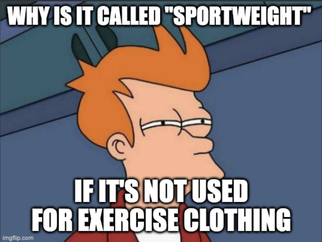|
Can you imagine knitted gym shorts? (Or, what does “sport-weight” mean?)
We’re going to move up the yarn weight scale a notch at a time for the duration of this series, and today we arrive at the “sport-weight” designation. The Craft Yarn Council defines sport-weight yarn as a yarn that achieves a crocheted gauge of 16-20 single crochet in 10 cm / 4” or a stockinette gauge of 23-26 stitches in 10 cm / 4”. In comparison to the fingering-weight yarns we looked at last week, you can see that this is a pretty limited gauge range - that will be the case for most yarn weights moving forward. An average hank of sport-weight yarn is going to come in somewhere between 297 - 348 meters per 100 grams, or 325 - 380 yards per 3.5 ounces. Examples of sport-weight yarns that we carry in our shop include Kelbourne Woolens Mojave, Juniper Moon Farms Patagonia, and Malabrigo Arroyo. Given American culture’s semi-obsession with sports and athletics and fitness, it’s a natural question to wonder what connection this type of yarn has with that world. Preppy tennis sweaters of a certain era or vintage bathing suits may be the only thing you can conjure up in your mind that would have perhaps been crocheted or knitted garments, but would that really have been enough to name an entire yarn category after sports? Short answer: the language and culture have shifted, and the popular meaning of “sport-weight” is now very different from what the term was originally coined to mean. There are all sorts of origin stories for the term “sportswear” depending on which sources you consult, but in general, it seems like the best description is that sportswear started out as collections of mix-and-match separates that were derived from types of actual clothing pieces worn by athletes. These separates were more relaxed than the typical silhouettes of clothing of the very early 20th century, less strictly relegated to specific activities or times of day, and - for women in particular - allowed them to dress themselves fashionably and easily without requiring the assistance of a maid. I found particularly interesting examples in an article attributed to Patricia Campbell Warner on LoveToKnow.com, titled simply “Sportswear.” Think of trousers, button-up shirts, cardigans, tunics, and turtleneck shirts. These separates were also made of materials that were easier to care for than more formal outfits, such as cotton, wool, and linen. Over the past few decades, the term “sportswear” has become more specifically linked to clothing you wear while participating in sports - in the US, we might call it “athleticwear,” or even “athleisure-wear” if you’re running errands in the same clothes you would wear to a yoga class or strength-training session. What used to be “sportswear” is now probably better called “business casual.” So what does this all have to do with yarn? Finer-gauge crocheted and knitted clothing is often perceived as dressier or appropriate for a wider range of settings - think of super-bulky pullover sweaters versus twin-set cardigans and shells. So the yarn that we now call “sport-weight” would originally have been used to make pieces of clothing that would have been appropriate to both pay a social call to an acquaintance and attend less rigidly formal social events, but not appropriate in an important business meeting or a high-society gathering. As a note, another name for this yarn weight is “baby yarn.” Again, “baby yarn” can be used to describe a number of characteristics of yarn but is normally used today to describe yarn that is both soft and easily washable. The use of the term “baby yarn” specifically tied with this size of yarn most likely has more to do with the development of easy-care yarns in acrylic and other synthetic materials in the period following World War II. As sportswear moved from natural materials to newly-developed synthetics, the same marketing push that encouraged homemakers to purchase clothing and home linens that could simply be thrown in a washing machine at any time also moved into the yarn market. Why risk making an heirloom sweater out of wool that could accidentally be felted or attacked by moths when you could pick up a skein of yarn specifically formulated to go in the washer any time the baby threw up on it or crawled through dirt? It’s fascinating to see what historical trends continue to play out in our use of language - stay tuned, as our next two installments will also have a lot to do with this idea!
1 Comment
Cathy
2/6/2024 09:21:13 pm
How interesting and curious. I assume these terms have stuck and no one cares to fix it to make sense
Reply
Leave a Reply. |
AuthorLindsey Spoor is the owner of Stilly River Yarns in Stanwood, WA. Archives
April 2024
Categories |
Reach out! |
Come visit us at our brick-and-mortar shop in Stanwood!
NEW LOCATION STARTING JULY 16, 2024:
7104 265th St. NW Suite 120 Stanwood, WA 98292 Shop phone: (360) 631-5801 Email: [email protected] Text: (515) 833-0689 |
|
|
Proudly powered by Weebly
Stilly River Yarns LLC
Copyright © 2024
Copyright © 2024


 RSS Feed
RSS Feed